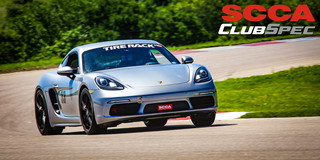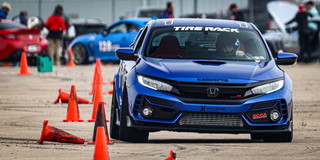
The following article was originally published in the March, 1972 issue of SportsCar Magazine. Mark Donohue looks forward to the 1972 Can-Am season, by reflecting on his career to that point. Donohue was not able to run a full season in 72 due to injuries sustained while testing the Porsche 917/10 at Road Atlanta. Teammate George Follmer took the Championship win and Donohue returned strong in 1973 to take the Championship in the 917/30.
At The Can-Am Series by Mark Donohue
I guess I can’t look forward to the Can-Am Series this year without taking a look back first. When I do that, I’m reminded that my career in racing would probably not be what it is today if it weren’t for some of the talented and generous people who have held out their hands to me along the way. I suppose that Walter Hansgen and Roger Penske have helped me most, especially at the crucial times when I thought about quitting, but there were others, lots more, without whom I might not have made it. But lets start at the beginning.
My first competitive event was a hillclimb, in my Corvette, back in 1960. Burge Hulett and I decided one Tuesday that we wanted to race. On Wednesday we went to an SCCA Regional dinner as guests of Ed Brown, and that Saturday we were rushing up the hill.
My first driver’s school was at Marlboro, a real twister of a circuit. My instructor was the AC Bristol driver, Pierre Mion. Pierre drove my Elva Courier for ten laps, got out and said: “Go ahead,” and I never saw him again. That is, not that day, anyway, and that was all the instruction I got.
I qualified for my SCCA license that weekend, which was par for the course in those days, and two weeks later entered a Lime Rock regional race where I finished fourth with my Elva. I was disappointed with being placed so far back, but consoled myself with what I felt was the sure knowledge that what the car lacked were those certain bits and pieces that could turn a street car into a racing machine. So I went over and had a chat with my mechanic, Lou Schultz, who gave me a list of what he figured we needed. I then coughed up seven hundred dollars and Lou bought and attached what I needed, and I headed for Vineland. I won that race and the next fourteen that followed.
In my first National race at Lime Rock, Charlie Kolb was considered the favorite, but my Courier ran beautifully and I managed to beat Charlie to the checker.
1961 was a whirlwind year as we traveled to National races all over the country. We criss-crossed from Daytona to Meadowdale, Watkins Glen, Cumberland, Lime Rock, Marlboro and even the airport race at Montgomery. It turned into a season-long battle between Peter Revson’s Morgan, and the Elvas of Jay Signore and myself. It was a tough season, but one from which I was able to emerge the victor. To this day, Jay Signore remains one of my best friends, while Peter Revson is still one of my closest rivals. It’s as though there hasn’t been any change from our early beginnings in amateur racing to the professional series we’re competing in today.
With the help of Lou Schultz, my Elva dealer, mechanic and friend, I sold the Courier and took delivery of an Elva Formula Junior. We took the car to Nassau for the Speedweeks, where I finished fourth behind Pete Lovely, Roger Penske and Pat Piggot.
The next two racers were at Daytona and Sebring. At Daytona I lost the engine and at Sebring the chassis broke. And by this time I was broke. I had to stop.
For the entire summer of ’62 I didn’t do anything. Not in racing, that is. But I did write a letter to Elva Cars in England to tell them what a shame it was that the chassis broke. In July, I got a pleasant surprise, as Elvas sent me a new one, free of charge! Between July and December, Hank Thorp and I changed the chassis and rebuilt the engine and, for a time, I was back in business. It was at the Refrigerator Bowl at Marlboro that following January where Charlie Hayes, in what I’m positive was a fit of insanity, bought the Elva—just in time to pay off the bank loan.
I was working as a technical consultant for a pulverizing company at the time, and decided to buy a V-8 Daimler SP-250 because I liked the sound of the engine. I entered five races, and lost five engines, one cylinder head, the brakes twice and the clutch once. My vacation was all used up and I was broke again. I was discouraged, but with Hank Thorp’s help we sold the car “in a basket.” Funny how these things work—shortly after the sale, I happened to stumble over the reason for the car’s engine failures, informed the new owner of some suggested modifications I would have incorporated—and wouldn’t you guess, the guy went on to win the next twelve races.
After three races in a Cobra for Jack Griffith (two wins and a DNF) I met Jimmy Carter who was then working as a mechanic for Lou Schultz. That’s where Malcolm Starr came onto the scene. Malcolm had a lot of money and really wanted to go racing. At Jimmy’s insistence Malcolm agreed to have Jimmy work on the car, have me teach Malcolm how to drive, oversee the preparation and supply the trailer and towcar. I would drive the Nationals and Malcolm the Regionals. So we bought a Lotus Ford Formula C and won the National Championship with it.
Towards the end of the year, I prevailed on Malcolm to continue with our arrangement but this time with a Ford Mustang. The partnership worked and we won another National Championship together.
For all of this, I made minimal use of my engineering training in the early years of my career. I couldn’t even adjust the valves on my first Elva. But the Elva helped me learn about basic maintenance. It was sheer necessity. I learned how to change the brakes, gearboxes, bearings, clutches, rearends, you name it. I looked at what other people were doing and tried to do better. But I was winning, and that’s what counts.
With the Daimler, I learned how to build (or rebuild) engines. I had to. I blew enough of them. Engine building, however, has never been my forte. But from my many unfortunate experiences with the Daimler, I graduated with honors in my studies on cams, rocker arms, ratios, clearances, camshaft design, carburetion, piston clearances, and all those precious details which have served me so well with the Penske Team. And the fact is, that I’m still not a Don Cox (Penske’s research engineer. Ed.) I learned from trial and error, mostly error, but I did come to understand what was going on.
About that time, I got an invitation to join the Road Racing Drivers Club. The president was then the late, great Walt Hansgen. Walt had more confidence in me than I did. His name was far better known in international circles than my baby-faced countenance. For all my doubts, Walt insisted that I be his co-driver for the famous endurance races at Daytona, Sebring and Le Mans in the big Ford GT. At first, Jacques Passino refused. But Walt insisted. Reluctantly, Passino relented and I had my first big change. Driving with Walt was a tremendous experience. I learned so much from him in so many ways. And we did well together. He became not just my friend, but my mentor, and when he was later killed in practice for Le Mans, I didn’t know what to do. I was lost.
It was soon after this tragedy, in 1966, that Roger Penske approached me and suggested that I test drive a car for him that would be driven by Dr. Dick Thompson. It proved the beginning of a most rewarding association. In fact, after my relationship with Walt Hansgen, this has been the second landmark in my competitive career.
Some people call me a perfectionist, and maybe in my own way I am. I always try to do my very best. My father once said: “If you take care of all the little things, the big things will take care of themselves.” It’s a philosophy that’s worked for me, especially in racing.
Without doubt, working inside of the Penske organization makes it easier for a man of my temperament to operate most efficiently. I’m a team man, and we are a team operation. Roger has a gift, no—maybe it’s a genius—for picking the right people for each job, and even more important, to pick the fellows who will mesh readily with the rest of us. The result is not just an assemblage of talent, because we certainly have loads of that, but a well-tuned team that works together.
Roger has never been willing to settle for anything but the best, or anything less than a first class effort. He believes in himself and in the men he has chosen to work with him. It makes for a touch combination to beat. I say this not just because I’m part of the organization, but because this is truly what Roger is like. Of course, Roger is better known for having a wrecked race car rebuilt over night and that sort of thing, but his capacity for coping with the unforeseen or unusual challenge is simply extraordinary.
I supposed that’s enough of looking back. I’m looking forward to driving the Porsche 917 in the ’72 Can-Am season. The only time I ever drove a Porsche before this effort was when I did an evaluation for the 912 and 911’s for one of the enthusiast books several years ago. Up to that time I had never driven a Porsche, either a street or race car. I thought it was great. Really impressed me.
As far as Porsche’s chances in the Can-Am are concerned, well, we can be very competitive. We’re very confident in what we have set out to do for this effort. Porsche is doing that part of the development and we can’t do and they are one of the greatest test and development organizations in racing today. Maybe the very best. At this moment we’re still testing both supercharged and unsupercharged engines. The test cars are tremendously strong, and I think are going to be the match of anything we go up against. Jackie Stewart and Denny Hulme, both driving for Team McLaren, pose quite a threat. We know that they’ll be tough and that they will be ready. But we have an excellent combination, and I’m really anxious to get a crack at them.










